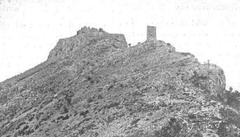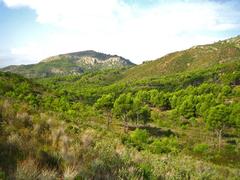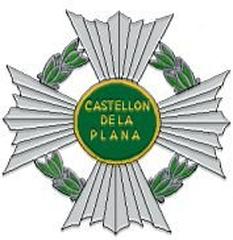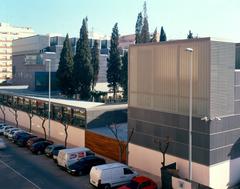Visiting Hours and Tickets for Castell de Miravet, Castelló de la Plana, Spain
Publication Date: 01/08/2024
Introduction: Discover the History and Significance of Castell de Miravet
Nestled in the picturesque region of Catalonia, Castell de Miravet stands as a testament to Spain’s rich medieval history and architectural prowess. Perched on a hilltop overlooking the serene Ebro River, this iconic fortress has evolved through various epochs, from its initial construction by the Moors in the 11th century to its transformation under Christian and Templar control in the mid-12th century. The castle’s strategic location and formidable defenses made it a pivotal stronghold during the Reconquista and other historical conflicts, including the Spanish Civil War (Lonely Planet).
Today, Castell de Miravet is not just a relic of the past but a vibrant cultural and historical landmark that attracts visitors from around the globe. Its blend of Islamic and Templar architectural influences, coupled with its significant role in the Reconquista, makes it a fascinating destination for history enthusiasts and architecture aficionados alike. This comprehensive guide aims to provide detailed insights into the castle’s rich history, visiting hours, ticket information, and practical travel tips, ensuring a memorable visit to this remarkable site (femturisme.cat).
Table of Contents
- Introduction
- Historical Background of Castell de Miravet
- Modern-Day Significance
- Visitor Experience
- Conclusion
- References and Further Reading
Historical Background of Castell de Miravet
Origins and Early History
The origins of Castell de Miravet trace back to its Arab roots, where it initially served as a fortress. The strategic location of the castle, perched on a watchtower overlooking the Ebro River, made it a significant defensive structure. The architectural style of the castle is reminiscent of the defensive structures found in the Holy Land, reflecting its Arab origins. The lower sections of the walls and parts of the sovereign enclosure still bear the marks of the old Andalusian fortress, showcasing the blend of cultures and architectural styles that have influenced the castle over the centuries (femturisme.cat).
Christian Conquest and Templar Influence
In 1153, the castle came under Christian control when it was captured by the forces of Ramón Berenguer IV. Recognizing its strategic importance, Ramón Berenguer IV entrusted the castle to Pedro de Rovira, the master of the Templars in Hispania and Provence. Under Rovira’s guidance, the castle underwent significant reconstruction and expansion, transforming it into one of the primary centers of Christian power in the Iberian Peninsula (femturisme.cat).
The Templars, known for their military prowess and architectural skills, erected the castle in a relatively short period. The uniform appearance of the construction suggests a well-coordinated and efficient building process. The castle’s design reflects the Templars’ expertise in creating formidable defensive structures, with its imposing walls and strategic layout.
Architectural Significance
Castell de Miravet stands as a remarkable example of the architecture of the Order of the Templars in Europe. The castle’s design follows the defensive style of the castles of the Holy Land, characterized by its majestic walls that rise over the Ebro River. The castle’s austere and imposing forms are a testament to its military purpose, designed to withstand sieges and attacks.
The walled citadel of Miravet, within which the castle is located, features buildings on different levels, creating a medieval beehive-like structure. This design ensured that all necessary elements for life were contained within the walls, providing a self-sufficient and secure environment for its inhabitants (femturisme.cat).
Role in the Reconquista
During the period of the Reconquista, Castell de Miravet played a crucial role as a stronghold for Christian forces. Its strategic location and formidable defenses made it a key asset in the efforts to reclaim territories from Muslim control. The castle served as a base for military operations and a symbol of Christian authority in the region.
The Templars’ presence at Miravet further solidified its importance. As a military and religious order, the Templars were instrumental in the Reconquista, providing both military support and spiritual guidance. The castle’s transformation under Templar control reflects the broader historical context of the Reconquista and the shifting power dynamics in the Iberian Peninsula.
Decline and Preservation
The decline of the Templars in the early 14th century marked a turning point for Castell de Miravet. Following the dissolution of the Templar Order, the castle’s significance waned, and it eventually fell into disrepair. However, its historical and architectural value was recognized, leading to efforts to preserve and restore the structure.
Today, Castell de Miravet stands as a testament to the rich and complex history of the region. The castle’s preservation allows visitors to explore its storied past and appreciate the architectural achievements of the Templars. The remains of the old Andalusian fortress, combined with the Templar additions, offer a unique glimpse into the cultural and historical layers that have shaped the castle over the centuries (femturisme.cat).
Modern-Day Significance
In contemporary times, Castell de Miravet has become a significant cultural and historical landmark. It is one of the best examples of Catalan military architecture from the 12th and 13th centuries, attracting visitors from around the world. The castle’s imposing structure and historical significance make it a popular destination for those interested in medieval history and architecture.
Visitor Information
Ticket Prices and Visiting Hours
The castle is open to visitors from Tuesday to Sunday, including holidays, with specific visiting hours. It is closed on non-holiday Mondays, December 25 and 26, and January 1 and 6. The ticket office and entrance close 30 minutes before the time limit, ensuring that visitors have ample time to explore the site. For the most up-to-date information on ticket prices and visiting hours, check the official website or local tourist information sites.
Travel Tips and Nearby Attractions
Visitors can reach Castell de Miravet by car or public transport. Parking is available near the castle. Nearby attractions include the Ebro River, where visitors can enjoy boating and scenic walks, and the charming village of Miravet, known for its pottery and local cuisine. Make sure to wear comfortable shoes as the terrain can be uneven.
Visitor Experience
Visitors to Castell de Miravet can participate in various activities and guided tours that enhance their understanding of the castle’s history and significance. One such activity is the “Family visit to Miravet Castle: A treasure, three cultures,” a dynamic and enriching experience suitable for all audiences. This clue game, based on ingenuity and research, allows participants to explore the castle’s history through the lens of three great cultures: Muslim, Christian, and Templar (femturisme.cat).
Guided tours of the castle provide an in-depth look at its most emblematic spaces and historical context. These tours offer visitors the opportunity to learn about the castle’s architectural features, its role in the Reconquista, and the daily life of its inhabitants. The guided tours are designed to be informative and engaging, making the history of Castell de Miravet accessible to a wide audience (femturisme.cat).
Special Events and Photographic Spots
Throughout the year, Castell de Miravet hosts special events, including medieval fairs, reenactments, and cultural festivals. These events provide a unique opportunity to experience the castle’s history firsthand. Additionally, the castle offers several picturesque spots perfect for photography, capturing the breathtaking views of the Ebro River and the surrounding landscapes.
Frequently Asked Questions (FAQ)
Q: What are the visiting hours for Castell de Miravet? A: The castle is open from Tuesday to Sunday, including holidays. It is closed on non-holiday Mondays, December 25 and 26, and January 1 and 6. Check the official website for specific hours.
Q: How much are the tickets for Castell de Miravet? A: Ticket prices may vary, so it’s best to check the official website or local tourist information for the most up-to-date pricing.
Q: Are there guided tours available? A: Yes, guided tours are available and provide an in-depth look at the castle’s history and architecture. These tours are highly recommended for a comprehensive experience.
Q: What nearby attractions can I visit? A: Nearby attractions include the Ebro River, the village of Miravet, and various local pottery shops and restaurants.
Q: Is Castell de Miravet accessible for people with disabilities? A: Some areas of the castle may be challenging to access due to uneven terrain. It’s recommended to contact the site in advance to discuss accessibility options.
Conclusion: Key Takeaways from Visiting Castell de Miravet
Castell de Miravet is more than just a historical monument; it is a symbol of the rich and complex history of Catalonia and Spain. From its origins as an Arab fortress to its transformation under the Knights Templar, the castle has witnessed significant historical events that shaped the region’s cultural and political landscape. Today, it stands as a well-preserved example of medieval military architecture, offering visitors a unique glimpse into the past (Patrimoni Gencat).
Visitors to Castell de Miravet can explore its storied past through guided tours, engaging activities, and special events that bring history to life. The castle’s strategic location also offers breathtaking views of the Ebro River and the surrounding landscapes, making it a perfect spot for photography and nature walks. Whether you are a history buff, an architecture enthusiast, or simply looking for a scenic getaway, Castell de Miravet promises a rich and rewarding experience (Miravet Info).
For those planning a visit, make sure to check the official website for the latest information on visiting hours and ticket prices, and don’t miss the nearby attractions and cultural experiences that the charming village of Miravet has to offer. Embrace the opportunity to step back in time and explore one of Catalonia’s most captivating historical sites (Spain.info).
References and Further Reading
- femturisme.cat. (n.d.). Castell de Miravet. Retrieved from femturisme.cat
- Patrimoni Gencat. (n.d.). Miravet Castle. Retrieved from Patrimoni Gencat
- Lonely Planet. (n.d.). Castell de Miravet. Retrieved from Lonely Planet
- Miravet Info. (n.d.). What to see in Miravet. Retrieved from Miravet Info
- Spain.info. (n.d.). Miravet Castle. Retrieved from Spain.info




